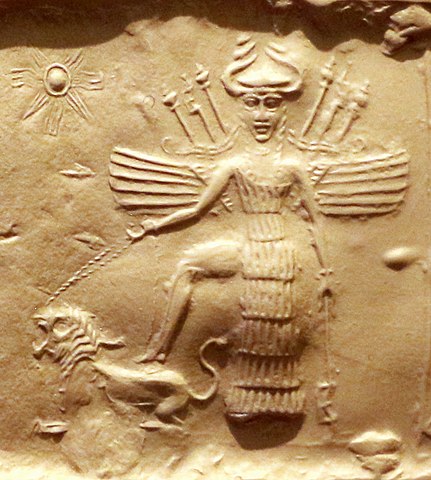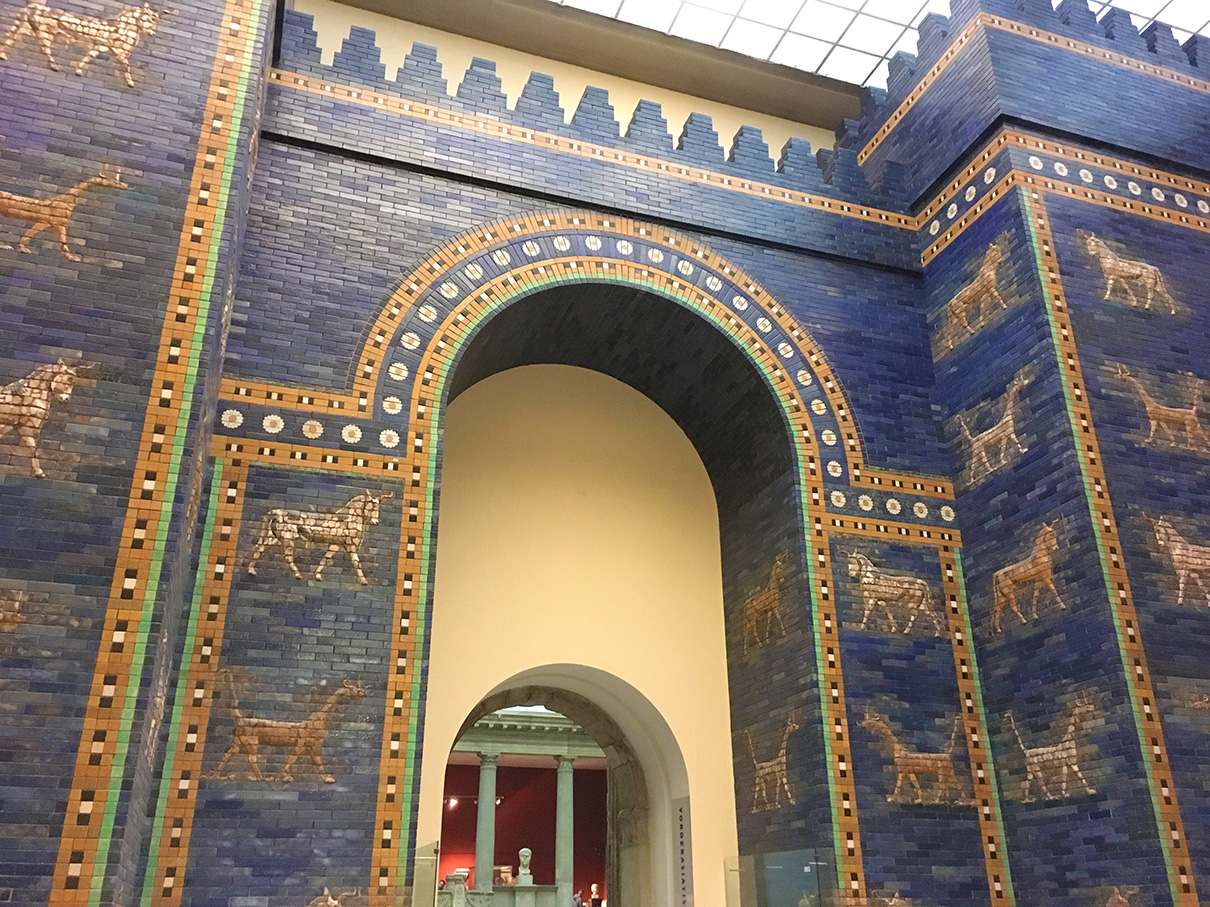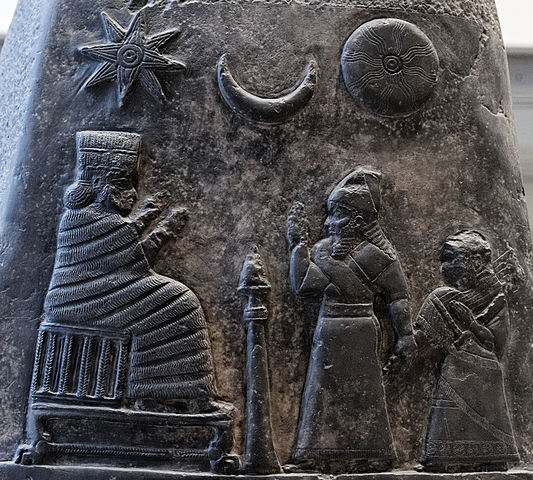Ishtar
Ishtar is the ancient goddess of love, war, and fertility worshipped in the Akkadian Empire, by the Babylonians, and Assyrians. She was originally worshipped in Sumer as Inanna.
She is also associated with beauty, sex, divine law, and political power. Her primary title was "the Queen of Heaven."
Name
Scholars believe that Inanna and Ishtar were originally separate, unrelated deities, but were conflated with one another during the reign of Sargon of Akkad and came to be regarded as effectively the same goddess under two different names. Inanna's name may derive from the Sumerian phrase nin-an-ak, meaning "Lady of Heaven," but the cuneiform sign for Inanna (𒈹) is not a ligature of the signs lady (Sumerian: nin; cuneiform: 𒊩𒌆 SAL.TUG2) and sky (Sumerian: an; cuneiform: 𒀭 AN).
These difficulties led some early Assyriologists to suggest that Inanna may have originally been a Proto-Euphratean goddess, who was only later accepted into the Sumerian pantheon. This idea was supported by Inanna's youthfulness, as well as the fact that, unlike the other Sumerian divinities, she seems to have initially lacked a distinct sphere of responsibilities. The view that there was a Proto-Euphratean substrate language in Southern Iraq before Sumerian is not widely accepted by modern Assyriologists.
Origin
As early as the Uruk period (c. 4000–3100 bce), Inanna was already associated with the city of Uruk. During this period, the symbol of a ring-headed doorpost was closely associated with Inanna. The famous Uruk Vase (found in a deposit of cult objects of the Uruk III period) depicts a row of naked men carrying various objects, including bowls, vessels, and baskets of farm products, and bringing sheep and goats to a female figure facing the ruler. The female stands in front of Inanna's symbol of the two twisted reeds of the doorpost, while the male figure holds a box and stack of bowls, the later cuneiform sign signifying the En, or high priest of the temple.
During the Akkadian period (c. 2334–2154 bce), following the conquests of Sargon of Akkad, Inanna and originally independent Ishtar became so extensively syncretized that they became regarded as effectively the same. The Akkadian poet Enheduanna, the daughter of Sargon, wrote numerous hymns to Inanna, identifying her with Ishtar. As a result of this, the popularity of Inanna/Ishtar's cult skyrocketed.
Ishtar was originally a goddess venerated in the Euphrates valley. An association between her and the desert poplar is attested in the most ancient texts from both Ebla and Mari. She as a moon god and a sun deity of varying gender (Shamash/Shapash) were the only deities shared between various early Semitic peoples of Mesopotamia and ancient Syria, who otherwise had different not necessarily overlapping pantheons.
Worship
In the Old Babylonian period, her main cult centers were Uruk, Zabalam and Agade, also Ilip. Her cult was also introduced from Uruk to Kish.
During later times, while her cult in Uruk continued to flourish, Ishtar also became particularly worshipped in the Upper Mesopotamian kingdom of Assyria (modern northern Iraq, northeast Syria and southeast Turkey), especially in the cities of Nineveh, Aššur and Arbela (modern Erbil). During the reign of the Assyrian king Assurbanipal, Ishtar rose to become the most important and widely venerated deity in the Assyrian pantheon, surpassing even the Assyrian national god Ashur. Votive objects found in her primary Assyrian temple indicate that she was a popular deity among women.
Individuals who went against the traditional gender binary were heavily involved in the cult of Inanna. During Sumerian times, a set of priests known as gala worked in Inanna's temples, where they performed elegies and lamentations. Men who became gala sometimes adopted female names and their songs were composed in the Sumerian eme-sal dialect, which, in literary texts, is normally reserved for the speech of female characters. Some Sumerian proverbs seem to suggest that gala had a reputation for engaging in anal sex with men. During the Akkadian Period, kurgarrū and assinnu were servants of Ishtar who dressed in female clothing and performed war dances in Ishtar's temples. Several Akkadian proverbs seem to suggest that they may have also had homosexual proclivities. Gwendolyn Leick, an anthropologist known for her writings on Mesopotamia, has compared these individuals to the contemporary Indian hijra. In one Akkadian hymn, Ishtar is described as transforming men into women.
Throughout the latter half of the twentieth century, it was widely believed that the cult of Inanna involved a "sacred marriage" ritual, in which a king would establish his legitimacy by taking on the role of Dumuzid and engaging in ritual sexual intercourse with the high priestess of Inanna, who took on the role of the goddess. This view, however, has been challenged and scholars continue to debate whether the sacred marriage described in literary texts involved any kind of physical ritual enactment at all and, if so, whether this ritual enactment involved actual intercourse or merely the symbolic representation of intercourse.
The cult of Ishtar was long thought to have involved sacred prostitution, but this is now rejected among many scholars. Slave women or female priests who worked within temples and served the sexual requests of visitors to the temple, known as ishtaritum, are reported to have worked in Ishtar's temples, but it is unclear if such priestesses actually performed any sex acts. Women across the ancient Near East worshipped Ishtar by dedicating to her cakes baked in ashes (known as kamān tumri). A dedication of this type is described in an Akkadian hymn. Several clay cake molds discovered at Mari are shaped like naked women with large hips clutching their breasts. Some scholars have suggested that the cakes made from these molds were intended as representations of Ishtar herself.
Symbols
Inanna/Ishtar's most common symbol was the eight-pointed star, though the exact number of points sometimes varies. Six-pointed stars also occur frequently, but their symbolic meaning is unknown. The eight-pointed star seems to have originally borne a general association with the heavens, but, by the Old Babylonian Period (c. 1830 – c. 1531 bce), it had come to be specifically associated with the planet Venus, with which Ishtar was identified. Starting during this same period, the star of Ishtar was normally enclosed within a circular disc. During later Babylonian times, slaves who worked in Ishtar's temples were sometimes branded with the seal of the eight-pointed star. On boundary stones and cylinder seals, the eight-pointed star is sometimes shown alongside the crescent moon, which was the symbol of Sin and the rayed solar disk, which was a symbol of Shamash.
Inanna's cuneiform ideogram was a hook-shaped twisted knot of reeds, representing the doorpost of the storehouse, a common symbol of fertility and plenty. The rosette was another important symbol of Inanna, which continued to be used as a symbol of Ishtar after their syncretism. During the Neo-Assyrian Period (911 – 609 bce), the rosette may have actually eclipsed the eight-pointed star and become Ishtar's primary symbol. The temple of Ishtar in the city of Aššur was adorned with numerous rosettes.
Inanna/Ishtar was associated with lions, which the ancient Mesopotamians regarded as a symbol of power.Her associations with lions began during Sumerian times; a chlorite bowl from the temple of Inanna at Nippur depicts a large feline battling a giant snake and a cuneiform inscription on the bowl reads "Inanna and the Serpent," indicating that the cat is supposed to represent the goddess. During the Akkadian Period, Ishtar was frequently depicted as a heavily armed warrior goddess with a lion as one of her attributes.
Doves were also prominent animal symbols associated with Inanna/Ishtar. Doves are shown on cultic objects associated with Inanna as early as the beginning of the third millennium bce. Lead dove figurines were discovered in the temple of Ishtar at Aššur, dating to the thirteenth century bce and a painted fresco from Mari, Syria shows a giant dove emerging from a palm tree in the temple of Ishtar, indicating that the goddess herself was sometimes believed to take the form of a dove.
Astrology
Inanna was associated with the planet Venus, which is named after her Roman equivalent Venus. In Inanna's Descent to the Underworld, unlike any other deity, Inanna is able to descend into the netherworld and return to the heavens. The planet Venus appears to make a similar descent, setting in the West and then rising again in the East.
Because the movements of Venus appear to be discontinuous (it disappears due to its proximity to the Sun, for many days at a time, and then reappears on the other horizon), some cultures did not recognize Venus as a single entity; instead, they assumed it to be two separate stars on each horizon: the morning and evening star. Nonetheless, a cylinder seal from the Jemdet Nasr period indicates that the ancient Sumerians knew that the morning and evening stars were the same celestial object. The discontinuous movements of Venus relate to both mythology as well as Inanna's dual nature.
Modern astrologers recognize the story of Inanna's descent into the underworld as a reference to an astronomical phenomenon associated with retrograde Venus. Seven days before retrograde Venus makes its inferior conjunction with the sun, it disappears from the evening sky. The seven day period between this disappearance and the conjunction itself is seen as the astronomical phenomenon on which the myth of descent was based. After the conjunction, seven more days elapse before Venus appears as the morning star, corresponding to the ascent from the underworld.
Inanna in her aspect as Anunītu was associated with the eastern fish of the last of the zodiacal constellations, Pisces. Her consort Dumuzi was associated with the contiguous first constellation, Aries.
Abilities
The Sumerians worshipped Inanna as the goddess of both warfare and love. Unlike other gods, whose roles were static and whose domains were limited, the stories of Inanna describe her as moving from conquest to conquest. She was portrayed as young and impetuous, constantly striving for more power than she had been allotted. Although she was worshipped as the goddess of love, Inanna was not the goddess of marriage, nor was she ever viewed as a mother goddess.
Inanna was also worshipped as one of the Sumerian war deities. Battle itself was occasionally referred to as the "Dance of Inanna." Epithets related to lions in particular were meant to highlight this aspect of her character. As a war goddess she was sometimes referred to with the name Irnina ("victory"). Assyrian royal curse-formulas invoked both of Ishtar's primary functions at once, invoking her to remove potency and martial valor alike. Mesopotamian texts indicate that traits perceived as heroic (such as a king's ability to lead his troops and to triumph over enemies) and sexual prowess were regarded as interconnected.
While Inanna/Ishtar was a goddess, her gender could be ambiguous at times. Gary Beckman states that "ambiguous gender identification" was a characteristic not just of Ishtar herself but of a category of deities he refers to as "Ishtar type" goddesses (such as Shaushka, Pinikir or Ninsianna). A late hymn contains the phrase "she [Ishtar] is Enlil, she is Ninil" which might be a reference to occasionally "dimorphic" character of Ishtar, in addition to serving as an exaltation. A hymn to Nanaya alludes to a male aspect of Ishtar from Babylon alongside a variety of more standard descriptions. However, Ilona Zsolnay only describes Ishtar as a "feminine figure who performed a masculine role" in certain contexts, for example as a war deity.
Modern views
In his 1853 pamphlet The Two Babylons, as part of his argument that Roman Catholicism is actually Babylonian paganism in disguise, Alexander Hislop, a Protestant minister in the Free Church of Scotland, incorrectly argued that the modern English word Easter must be derived from Ishtar due to the phonetic similarity of the two words. Modern scholars have unanimously rejected Hislop's arguments as erroneous and based on a flawed understanding of Babylonian religion. Nonetheless, Hislop's book is still popular among some groups of evangelical Protestants.
Inanna has become an important figure in modern feminist theory because she appears in the male-dominated Sumerian pantheon, but is equally as powerful, if not more powerful than, the male deities she appears alongside. In this context, she is sometimes conflated with Lilith.
Inanna is the primary ancient source for Aleister Crowley's Babalon, a principal goddess in the religion Thelema. Inanna's name is also used to refer to the Goddess in modern Neopaganism and Wicca. Her name occurs in the refrain of the "Burning Times Chant," one of the most widely used Wiccan liturgies. Inanna's Descent into the Underworld was the inspiration for the "Descent of the Goddess," one of the most popular texts of Gardnerian Wicca.
Paul Thomas, a scholar of new religious movements, has criticized the modern portrayal of Inanna, accusing it of anachronistically imposing modern gender conventions on the ancient Sumerian story, portraying Inanna as a wife and mother, two roles the ancient Sumerians never ascribed to her, while ignoring the more masculine elements of Inanna's cult, particularly her associations with warfare and violence. Gary Beckman, a researcher of religions of ancient Near East, calls neopagan authors "not revivalists, but inventors," and notes that they often "incorrectly view all historically attested female divinities as full or partial manifestations of a single figure," and highlights that while Ishtar did overshadow many other deities, she was never a "single Goddess."


